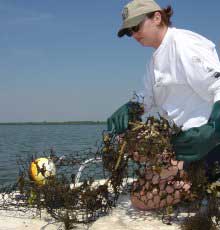|
Join the Ghostbusters!
Recruits Sought for November Event
If you have a shallow-draft boat, now's your chance to become a ghostbuster.
After a small group of volunteers pulled more than 100 abandoned crab traps - or ghost traps - from Tampa Bay one day last spring, organizers scheduled a larger event for Saturday, November 20.
"We'll get steering committee members in the water the week before to mark the traps and then we'll get volunteers out on Saturday to pull them," said Peter Clark, executive director of Tampa Bay Watch and a member of the Pinellas County Environmental Fund's ghostbuster committee. "We'll need more specialized volunteers for this project than normal, but we're working on building a database of boaters who can help out."
Approximately 30 to 50% of the 350,000 crab traps fished in Florida waters become ghost traps every year, abandoned at the end of a season or lost when lines break in heavy seas. Ghost traps don't stop working just because no one is there to empty them. Crabs that enter the trap for the original bait die and become bait themselves, attracting a wide variety of wildlife, from diamondback terrapin and river otters to spotted seatrout, red drum, black drum and flounder.
In fact, a Louisiana study indicates that ghost traps catch and kill 25.8 crabs per trap - for a total of four to 10 million crabs every year. In Texas, where more than 12,000 ghost traps have been retrieved since 2002, officials documented 22 species of bycatch, including blue crabs, stone crabs and commercially important fish.
Those numbers may be different in Florida, where biodegradable panels that allow crabs and fish to escape are required, but the sheer number of traps lost annually implies huge losses. If half of the lost traps catch half of the crabs documented as killed in Louisiana, more than two million crabs die in Florida's ghost traps every year.
"People in Florida have been crabbing for years and years, and some of those old traps are still out there," Clark said. "And the number of lost traps increased after the gill net ban because netters began to fish for crabs instead."
Along with bycatch, the wire traps can be dangerous to humans. As they slowly disintegrate and sink into sand, "they'll tear you up if you step on one," Clark said. Traps made of durable vinyl-coated wire also can easily damage outboard motors or propellers.
|

Ghost traps don’t stop catching wildlife
just because no one empties them.


|

